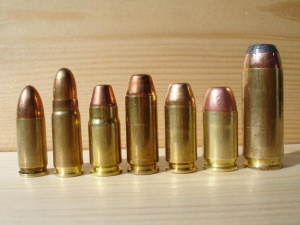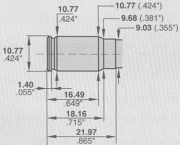.357 SIG
| .357 SIG | ||||||||||||||||
|---|---|---|---|---|---|---|---|---|---|---|---|---|---|---|---|---|

| ||||||||||||||||
| .357 SIG (third from left) in comparison with other cartridges (from left: 9x19mm Parabellum, 7.62x25mm Tokarev, .357 SIG, 10 mm Auto, .40 S&W, .45 GAP, .50 Action Express) | ||||||||||||||||
| Type | Pistol | |||||||||||||||
| Country of Origin | Switzerland, USA | |||||||||||||||
| Specifications | ||||||||||||||||
| Case Type | Rimless, bottleneck | |||||||||||||||
| Bullet Ø | .355 in (9.0 mm) | |||||||||||||||
| Neck Ø | .381 in (9.7 mm) | |||||||||||||||
| Shoulder Ø | .424 in (10.8 mm) | |||||||||||||||
| Base Ø | .424 in (10.8 mm) | |||||||||||||||
| Rim Ø | .424 in (10.8 mm) | |||||||||||||||
| Rim Thickness | .055 in (1.4 mm) | |||||||||||||||
| Case Length | .865 in (22.0 mm) | |||||||||||||||
| Full Length | 1.14 in (29 mm) | |||||||||||||||
| Primer | Small pistol | |||||||||||||||
| Max. pressure | 44,236 psi (305.00 MPa) | |||||||||||||||
| Production & Service | ||||||||||||||||
| Designer | SIGARMS/Federal Cartridge Co. | |||||||||||||||
| Design Date | 1994 | |||||||||||||||
| Production Dates | 1994- | |||||||||||||||
| In Service | 1995-present | |||||||||||||||
| Used By | See Implementation | |||||||||||||||
| Wars | Afghanistan (JTF2)? | |||||||||||||||
| Ballistic Performance Sampling | ||||||||||||||||
| ||||||||||||||||
The .357 SIG pistol cartridge is the product of Swiss firearms manufacturer SIG-Sauer, in cooperation with the American ammunition manufacturer Federal Cartridge. While it is based on a .40 S&W case necked down to accept .355 inch bullets, the .357 SIG brass is longer. See the Handloading section for more information.
Contents |
[edit] History
Developed in 1994, the new cartridge was named "357" to highlight its purpose: to duplicate the performance of 125-grain (8.1 g) .357 Magnum loads fired from 4-inch (100 mm) barreled revolvers, in a cartridge designed to be used in a semi-automatic pistol.
Until the .357 SIG, there was no practical semi-automatic pistol round with the same performance as the 125 gr .357 Magnum revolver bullet. There were some semi-automatic pistols chambered for .357 Magnum, e.g., the Desert Eagle and Coonan, but due to the difficulty of designing a semi-automatic pistol able to feed the rimmed .357 Magnum cartridge reliably, they were of an impractical size and price.
The .357 SIG provided a self-defense cartridge close in performance to a 125 gr .357 Magnum, but from a smaller and more concealable semi-automatic pistol.
The .357 SIG was the first modern bottleneck commercial handgun cartridge since the early 1960s, when Remington introduced the unsuccessful .22 Remington Jet (1961), which necked a .357 Magnum case down to a .22 caliber bullet, and the .221 Remington Fireball (1963). Soon after the .357 SIG, other bottleneck commercial handgun cartridges appeared: the .400 Corbon (1996), necking the .45 ACP down to .40 caliber; the .25 NAA (1999), necking the .32 ACP down to .25 caliber; and the .32 NAA (2002), necking the .380 ACP down to .32 caliber.
[edit] Conversions
Most .40 S&W pistols can be converted to .357 SIG by replacing the barrel, and sometimes the recoil spring but many can be converted with just the barrel change. Pistols with especially strong recoil springs can accept either cartridge with a barrel change. Magazines will freely interchange between the two cartridges in most pistols, though there are exceptions like the .357 SIG chambered Sig 239. .357 SIG barrel kits have allowed this cartridge to gain in popularity among handgun owners. However, the .357 SIG is loaded to higher pressures than the .40 S&W (a difference of up to 5,000 psi at top loads), and may not be suitable for use in all .40 S&W-chambered pistols.
[edit] Characteristics

The goal of the .357 SIG project was to offer at least the level of performance of lighter .357 Magnum loads and +P/+P+ 9x19mm Parabellum loads. The .357 SIG accomplishes this goal with a 125 grain (8.1 g) bullet. Using heavier bullets, however, shows the cartridge to be somewhat inferior to the original Magnum. The recoil of the .357 SIG cartridge is strong, often noticeably more so than the .40 S&W, but not so much as full-power 10 mm Auto loads or the original .357 Magnum.
Like the 10 mm Auto, the .357 SIG can be down-loaded to reduce recoil, to the point where recoil is similar to that of a 9x19mm Parabellum. However, since the .357 SIG uses bullets that are generally the same as those used in the 9 mm Para,[1] downloading it to this point would defeat the purpose of having the SIG cartridge in the first place, as recoil and ballistics would be identical to the less-powerful 9 mm cartridge.
Because the .357 SIG fires at relatively high pressures muzzle flash and noise are significant with standard loads, even with longer barrels. Utilizing loads with specialized powders and experimenting with different bullet weights can reduce flash.
[edit] Handloading
Although the .357 SIG design is based on the .40 S&W case, handloaders cannot form .40 S&W cases into .357 SIG brass. While the two cases are identical in rim diameter, using the .40 S&W case will result in a case that is approximately 0.020 in (0.508 mm) too short. Unlike most bottlenecked cartridges, the .357 SIG headspaces on the case mouth;[1] cartridges that are too short can result in malfunctions which may cause serious injury. Furthermore, the SAAMI limit is lower at 35,000 PSI for the .40 cartridge than the 40,000 PSI for the .357 SIG.
While some people have attempted to form .357 SIG cases from 10 mm Auto cases, this is rather impractical. First of all, the change in primer type (10 mm uses large pistol primers, .357 SIG uses small pistol primers) would require that known recipes be scrapped, and second, the cost of using expensive 10 mm brass for such a purpose would certainly defeat the goal of saving money by reloading. Both unfired and once-fired .357 SIG brass are readily available at low cost from several well-known vendors.
Choosing the correct bullet type is extremely important when handloading the .357 SIG cartridge. The short neck of the casing makes the use of standard round-nosed bullets impractical: there is simply not enough flat area for the neck to "grip" the bullet, so flat-point bullets are used. Various 9 mm hollow-point bullets can also be successfully used, but due to the wide variety of choice, the chances of success vary from one brand to another.
[edit] Performance
Because of its relatively high velocity for a handgun round, the .357 SIG has a very flat trajectory, extending the effective range. However, it does not quite reach the performance of the .357 Magnum with bullets heavier than 125 grains (8.1 g), with the same usable barrel lengths, the typical commercial loadings using 125-grain (8.1 g) bullets, fired from a four-inch (102 mm) barrel; a typical commercial .357 Magnum load propels a 125-grain (8.1 g) bullet to 1,450 ft/s (440 m/s), while a typical .357 SIG load propels the same bullet to 1,350 ft/s (410 m/s), with only a usable 2.85-inch (72 mm) barrel. Specialty loads, such as Double Tap Ammunition, are able to propel a 125-grain (8.1 g) bullet to 1,450 ft/s (440 m/s) from a four-inch (102 mm) barrel. Offsetting this general slight disadvantage in performance is the fact that semi-automatic pistols tend to carry considerably more ammunition than revolvers.
However, this comparatively high velocity can also create the potential for overpenetration. The .357 SIG, much like the .357 Magnum and the similarly necked 7.62x25mm Tokarev, is well-suited for use with bullets that are designed to defeat body armor. Also like the Tokarev, the .357 SIG works well when shooting through barriers. There has been a documented case in Texas where a police officer's .45 round did not penetrate a tractor-trailer's shell, but a .357 SIG round from a backup officer's gun did, killing the suspect inside.[2] The round's ability to penetrate barriers is the main reason for its adoption by law enforcement agencies.
The reputation that the .357 SIG round had for losing its crimp (allowing for bullet setback) was partially true when the cartridge was new and ammunition manufacturers were just beginning to produce the round. These problems have since been corrected by major manufacturers. As a result, the round now exhibits nominal setback characteristics, similar to other cartridges.
The bottleneck shape of the .357 SIG cartridge makes feeding problems almost non-existent. This is because the bullet is channeled through the larger chamber before being seated entirely as the slide goes into full battery. Flat point bullets are seldom used with other autoloader platforms because of feeding problems; however, such bullets are commonly seen in the .357 SIG chambering and are quite reliable, as are hollow-point bullets.
One disadvantage of the .357 SIG is that it fires a .355" bullet at higher velocities than most bullets of that caliber are designed for. Very few bullets have been designed specifically for the .357 SIG, and .357 Magnum bullets that are designed for the same velocity range cannot be used due to their slightly larger diameter. Because of this, there are fewer ammunition choices in .357 SIG than one might expect for a cartridge using .355" bullets.
Another drawback of the .357 SIG is its often harsh treatment of the pistols that are chambered for it. Many are designed to fire the .40 S&W and are later modified for use with the .357 SIG. Firing regularly at pressure levels beyond what the pistol was designed for accelerates wear.
The "Accurate Powder" reloading manuals claims that it is "without a doubt the most ballistically consistent handgun cartridge we have ever worked with."[3]
[edit] Implementation
The SIG-Sauer P229 in .357 SIG is currently the standard issue firearm carried by agents of the United States Secret Service and Federal Protective Service, the Bastrop County Texas Sheriff's Office, the North Carolina State Highway Patrol, Delaware State Police, Alameda County Sheriff's Office, Virginia State Police, Federal Air Marshals and the IRS Criminal Investigation Division. In most cases, it has replaced 10 mm, .40 S&W and 9 mm loads. In 1995, the Texas Department of Public Safety became the first government agency to implement the .357 SIG. The Tennessee Highway Patrol presently issues the Glock 31 pistol chambered in .357 SIG.
While the Canadian Forces Special Operations unit Joint Task Force 2 reportedly uses P226's chambered in .357 SIG, this cannot be confirmed due to the highly secretive nature of the unit.